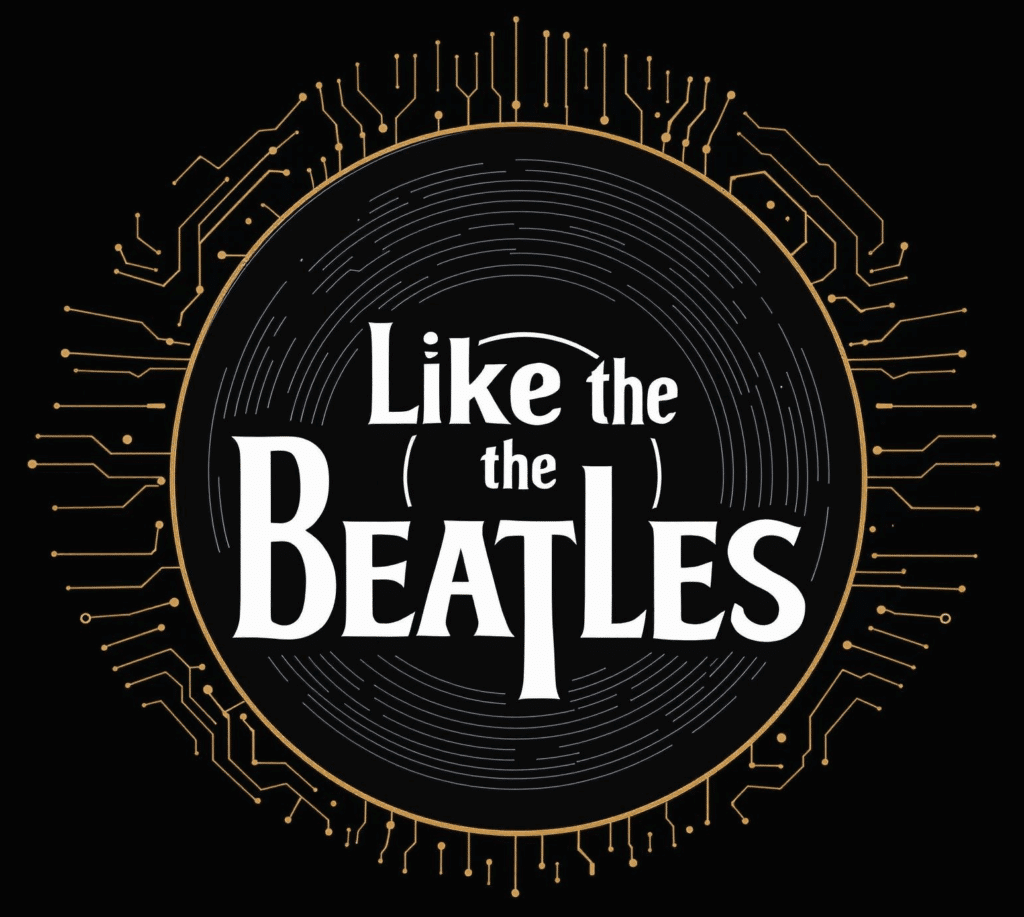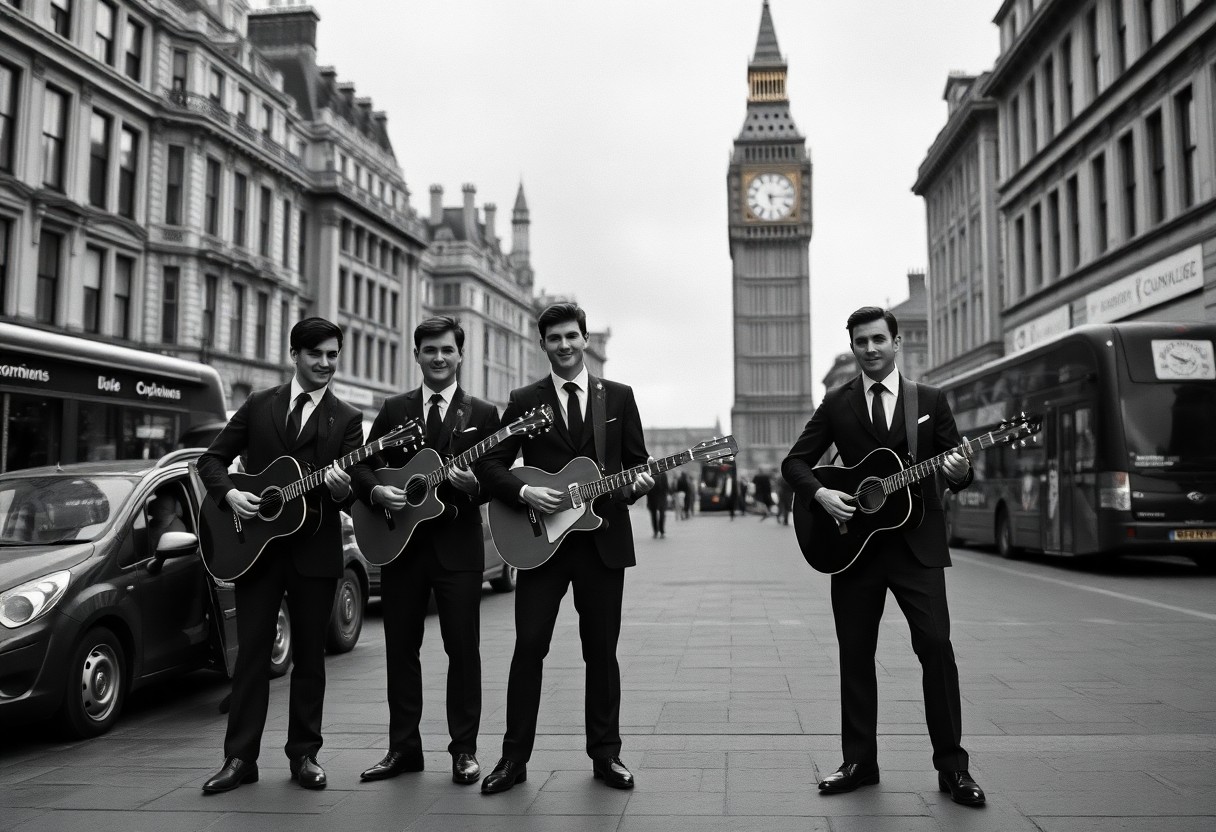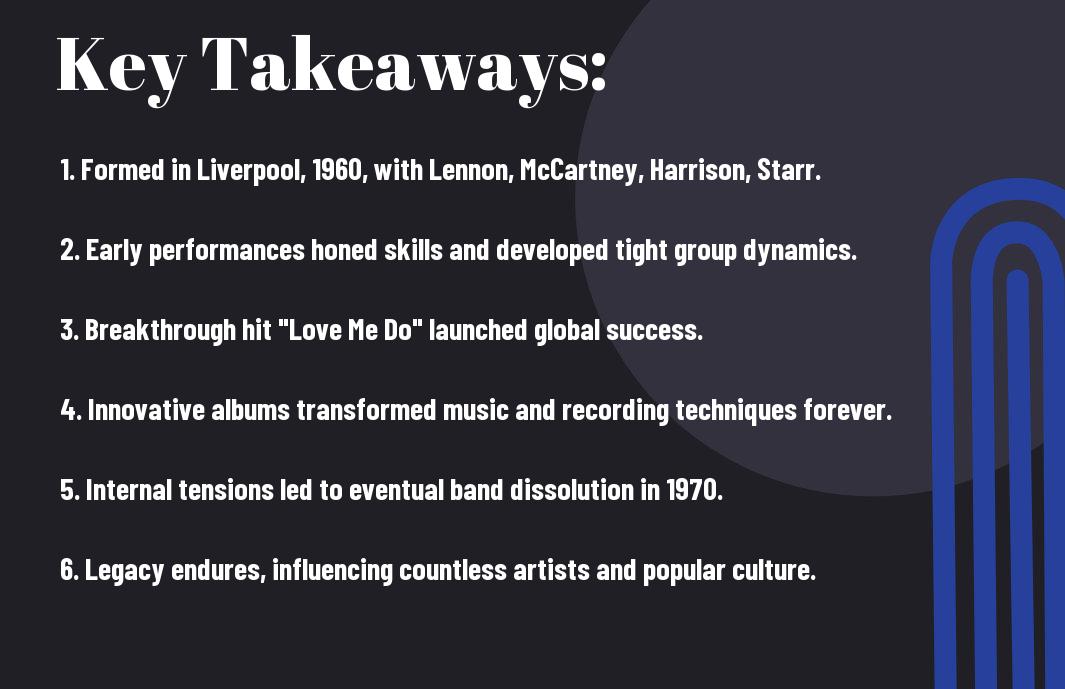It’s fascinating to explore the journey of The Beatles, one of the most iconic bands in music history. In this post, I’ll guide you through 10 unforgettable steps that shaped their rise, from their early days in Liverpool to their impactful farewell. You’ll discover the pivotal moments that defined their sound, the challenges they faced, and the remarkable influence they’ve had on generations. Join me as we examine into how this legendary group not only transformed music but also left an indelible mark on culture worldwide.
The Early Days: Formation of the Band
While the landscape of music was rapidly evolving in the 1950s, four young musicians in Liverpool were on the verge of creating a phenomenon. Paul McCartney, John Lennon, George Harrison, and later, Ringo Starr, would soon form a band that would defy conventions and leave an indelible mark on the world. Their journey began in small clubs, where they played gigs that would lay the foundation for their extraordinary career.
Meeting in Liverpool
Between the bustling streets of Liverpool and its vibrant music scene, the future members of The Beatles crossed paths in a serendipitous confluence of talent and ambition. John Lennon and Paul McCartney initially met at a church fair in 1957, sparking a friendship that would ultimately lead to the formation of the most iconic band in history.
The Early Line-up
On their path to fame, The Beatles underwent several changes in their line-up, first starting with the dynamic duo of Lennon and McCartney, who were later joined by Harrison and then Starr. Each member contributed distinct talents: John was known for his sharp wit and unique songwriting, Paul brought melodic sensibility, George added lead guitar skill, and Ringo provided an upbeat rhythm. Their chemistry was immediate, and together they developed a sound that would eventually evolve into one of the most celebrated styles in music history.
A pivotal moment in The Beatles’ early formation was the inclusion of Ringo Starr, who replaced Pete Best as the drummer in 1962. This change solidified their line-up, and Ringo’s easygoing personality complemented the already dynamic trio of Lennon, McCartney, and Harrison. The combination of their individual strengths created an energetic synergy that propelled them forward, enabling them to capture the hearts of fans while redefining contemporary music. As they began to take the stage, the world could not have anticipated the magic that was about to unfold.
Rise to Fame: The Beatlemania Era
Clearly, the emergence of Beatlemania transformed the music landscape forever, taking the world by storm in the early 1960s. Their innovative sound and charismatic personalities captivated millions, leading to a massive cultural phenomenon. As noted in a recent article, The Beatles Harness AI to Create Final Record, Featuring … highlights the lasting impact they made and continue to have on music and popular culture.
First Hits and Initial Success
Along their journey, The Beatles swiftly achieved their first hits, with tracks like “Love Me Do” and “Please Please Me” catapulting them into the spotlight. Their knack for catchy melodies and relatable lyrics resonated with the youth of the time, setting the stage for their monumental success and laying the groundwork for their lasting legacy.
Touring and Global Popularity
Any discussion about their fame would be incomplete without mentioning their relentless touring schedule, which played a crucial role in their engrossing rise. Overwhelmingly embraced, The Beatles became global icons, drawing *unprecedented crowds and immense attention*. Their concerts were often chaotic, marked by *screaming fans and frenzied excitement*, which solidified their reputation worldwide.
Hence, the *gripping atmosphere* at their performances showcased the *power of live music*, bringing entire cities to a standstill. I recall how each concert saw fans screaming at the top of their lungs, creating a palpable sense of exhilaration. Their *remarkable chemistry on stage* and *unique sound* made them pioneers of modern pop music, forging a path for future artists while redefining the concert experience. The overwhelming popularity of The Beatles showcased how deeply intertwined music and culture had become during the tumultuous 1960s, making them true legends of their time.
Creative Evolution: The Studio Era
For The Beatles, the studio era marked a transformative journey that redefined not only their sound but also the landscape of popular music. As they transitioned from performing live to exploring the studio as an instrument itself, I watched them push boundaries, experiment with new techniques, and craft masterpieces that reflected their growth as artists. Each album during this time unveiled a deeper layer of their creativity, engaging fans in ways that resonated long after the last note faded.
Innovative Albums and Artistic Growth
An exploration of The Beatles’ innovative albums reveals how they honed their craft and expanded their artistic vision. From the tight harmonies of “Rubber Soul” to the elaborate arrangements in “Sgt. Pepper’s Lonely Hearts Club Band,” I see a clear trajectory of growth where each release showcased their willingness to experiment and reinvent themselves.
Influence of Psychedelia and Experimentation
By incorporating elements of psychedelia and embracing experimentation, The Beatles created music that challenged societal norms and broadened the concept of popular music. Their willingness to investigate new sounds and ideas brought forth a rich tapestry of auditory experiences that captured the essence of the 1960s cultural revolution.
Influence of psychedelia and experimentation played a significant role in The Beatles’ evolution during the studio era. I noticed how they embraced unconventional sounds, employing techniques like reverse tape loops and sitar, which added a unique flavor to their music. Their groundbreaking approach to songwriting and recording, especially evident in albums like “Revolver” and “Sgt. Pepper,” not only transformed their own music but also had a lasting impact on artists across genres. This bold exploration allowed them to connect with the counterculture of the time and engage listeners in a way that felt genuinely revolutionary.
Cultural Impact: The Beatles in Society
Once again, I find the cultural significance of The Beatles remarkable. Their music transcended generations, influencing not only the soundscape of the 1960s but also reshaping social norms. As voices of a pivotal movement, they played a vital role in challenging traditional values, promoting peace, and fostering a sense of global community. The Beatles didn’t just create songs; they sparked a cultural revolution that redefined art, music, and youthful expression across the globe.
Music and Fashion Trends
For many, The Beatles redefined music and fashion, setting trends that echoed through the decades. From their early, mop-top hairstyles to iconic suits, their appearance became synonymous with a new era of self-expression. You could see influences in everything from psychedelic prints to the rise of casual attire as they evolved, leaving an indelible mark on how we perceive style and artistic expression. The Beatles taught us that music and fashion go hand in hand in creating a cultural identity.
Political and Social Influence
Cultural change often mirrors political and social shifts, and The Beatles were at the forefront of this dynamic. Their anti-war sentiments and messages of love resonated during a tumultuous time, making them not just musicians but influential voices of a generation. To understand their impact, consider how their lyrics became anthems of peace during the Vietnam War, promoting messages of unity amid societal division. As cultural icons, they encouraged a movement that embraced love and tolerance, challenging norms and inspiring activism that would shape the future.
The Turbulent Times: Internal Struggles
To understand the evolution of The Beatles, we must examine the intense internal struggles that defined their journey. As the band soared to unprecedented heights, personal conflicts, creative differences, and external pressures began to take a toll on their once-unbreakable bond. These challenges not only shaped their music but also marked the beginning of the end for the iconic group.
Conflicts and Changes in Line-up
Below the surface of their public persona, the tension among the band members simmered. Each artist began to assert their creative vision, leading to disagreements over direction, songwriting credits, and personal priorities. This friction eventually resulted in significant changes in line-up, particularly with the announcement of George Harrison‘s temporary departures and challenges in collaborations.
The Business of Being The Beatles
Struggles within the band were compounded by the overwhelming demands of fame and the complexities of their business dealings. The pressure to consistently produce hit records, coupled with tight schedules and stressful contracts, took a toll on their relationships. The financial stakes were high, and the management decisions often placed the band at odds, leading to feelings of betrayal and anxiety about their artistic freedoms.
Also, the relentless touring and promotional activities overshadowed their creative process, forcing them into a mechanical routine that stifled innovation. The challenge of balancing their individual aspirations with their shared identity as The Beatles created an environment of tension. This reality pushed members to explore solo projects, highlighting the burgeoning need for personal expression. These internal struggles foreshadowed a significant shift in the band’s dynamics, eventually altering the trajectory of their illustrious career.
Farewell: The Final Years
Not many bands can claim a legacy as profound as The Beatles. In their final years, they faced personal and creative challenges that ultimately led to their dissolution. Tensions grew within the group, particularly regarding musical direction and individual pursuits, culminating in a bittersweet farewell that left fans yearning for more. Despite their split, the impact of their music continued to resonate globally, solidifying their status as legends in the rock genre.
Last Albums and Breakup
Albums such as “Let It Be” and “Abbey Road” showcased The Beatles’ evolution and the strain in their relationships. The creative process became increasingly difficult, with each member pursuing solo projects that highlighted their individual talents. This was a period of conflicting visions, ultimately leading to their breakup in 1970—a significant moment in music history that sparked widespread reflection and analysis.
Legacy and Influence Post-Breakup
Any discussion about The Beatles is incomplete without addressing their profound influence on music and culture after their breakup. Their innovative sound and daring experimentation set new standards for what could be achieved in popular music. Artists across genres cite The Beatles as a major inspiration, demonstrating the band’s enduring legacy that continues to shape modern music.
Considering the lasting impact of The Beatles, their music serves as a powerful reminder of the artistic freedom that can emerge from collaboration, yet also highlights the personal struggles that can arise. They redefined popular music and pushed the boundaries of creativity, influencing subsequent generations to explore new artistic avenues. The result was a rich tapestry of sounds that affected not just music but also fashion, social movements, and popular culture, marking The Beatles as one of the most significant cultural phenomena of our time.
Final Words
Ultimately, my journey through the ten unforgettable steps from The Beatles’ formation to their farewell has deepened my appreciation for their impact on music and culture. By exploring their beginnings, groundbreaking innovations, and the poignant moments leading to their split, I hope you gained insights into why their legacy endures. Their story is not just about a band; it’s a reflection of creativity, collaboration, and change. I encourage you to examine into their music and history, allowing their artistry to resonate within your own journey.












